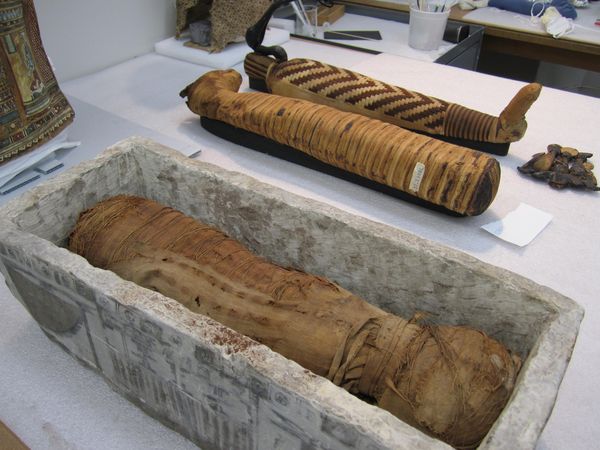Animal Mummies – X-radiography, and coming soon – CT scans!
These past few weeks we have been steadily packing and preparing to transport a group of animal mummies to the Animal Medical Center (AMC) for CT scanning with radiologist Anthony Fischetti, DVM, MS. In earlier blog posts we described the CT scanning of Brooklyn’s human mummies, but we have yet to CT scan our animals.
 As you may remember from an earlier post, Dr. Fischetti and a colleague came out to the Conservation Lab to look at a group of x-rays of animal mummies. It was at that time that we discussed the possibility of CT scanning the animal mummies. While x-radiographs are very useful for showing the interior of the mummy bundles, they will not give a three dimensional image that can be manipulated. With CT scans it is often possible to discern what might be inside the animal as opposed to lying within the linen wrapping of the mummy bundle. X-radiographs of the animals will aid in the CT scanning as it will give a kind of road map and some indication of areas we would like to focus on in the scanning process. Colleagues at other institutions have used CT scanning for animal mummies; the Phoebe Hearst Museum, part of UC Berkley recently scanned their adult crocodile and found a fishing hook inside!
As you may remember from an earlier post, Dr. Fischetti and a colleague came out to the Conservation Lab to look at a group of x-rays of animal mummies. It was at that time that we discussed the possibility of CT scanning the animal mummies. While x-radiographs are very useful for showing the interior of the mummy bundles, they will not give a three dimensional image that can be manipulated. With CT scans it is often possible to discern what might be inside the animal as opposed to lying within the linen wrapping of the mummy bundle. X-radiographs of the animals will aid in the CT scanning as it will give a kind of road map and some indication of areas we would like to focus on in the scanning process. Colleagues at other institutions have used CT scanning for animal mummies; the Phoebe Hearst Museum, part of UC Berkley recently scanned their adult crocodile and found a fishing hook inside!

Animal mummies in the Conservation Lab getting ready for transport to Animal Medical Center for CT Scanning.
While we don’t have that large of a crocodile, we will be taking several cats, birds, baby crocodiles, mice, and unknowns to the AMC to see what we can see. There we will have access to experts who can help identify the animals, and their possible cause of death. As Dr. Fischetti is partial to cats, we have also consulted with Dr. Andrew Major who got his veterinary medicine degree at the University of Pennsylvania and works as the emergency vet for The Raptor Trust. Since his work with raptors and other birds of prey for The Raptor Trust involves treating broken bones he has a lot of experience looking at bones in x-rays. One of the most common birds used in ancient Egyptian mummies is an ibis but hawks and other birds were also used.
This project studying the animal mummies in Brooklyn’s collection will eventually culminate into an exhibition currently scheduled for 2013.

Lisa Bruno is the head conservator of objects at the Brooklyn Museum, where she has been working since 1993. She has previously worked at the Art Institute of Chicago, and has had internships at The Cleveland Museum of Art, the Detroit Institute of Arts, and in private practice. She has a Masters Degree in Art Conservation from the University of Delaware, Winterthur Museum Art Conservation Department. She is a Professional Associate of the American Institute for Conservation.
